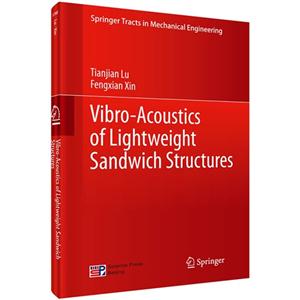轻质夹层板结构的声振耦合理论
本书特色
[
《轻质夹层板结构的声振耦合理论(英文版)》的内容主要包括:**部分,双板空腔结构声振耦合特性理论与实验研究,主要针对高速机车、大型客机及高档居民楼上所采用的双层玻璃窗及双层壳体结构的声振耦合特性开展理论与实验研究;第二部分,外部流场作用下板壳结构声振耦合特性理论研究,重点考虑了飞机在巡航飞行状态时外部平均流对飞机喷气发动机产生的噪声从舱外传入舱内的物理过程;第三部分,正交加筋夹层板结构声振耦合特性理论研究,重点分析讨论了水面舰艇和潜水艇外壳结构经常使用的正交加筋夹层板结构的声辐射特性和结构传声特性;第四部分,填充吸声材料夹层板结构声振耦合特性研究及优化设计,主要理论研究了航空航天飞行器中常用到的层芯空腔填充多孔纤维吸声材料的加筋夹层板结构的声振耦合特性及其结构优化设计;第五部分,研究展望,结合国家重大项目发展需求,展望了复杂周期加筋板壳结构在外部声场及流场作用下的声振耦合特性未来的研究趋势,提出了值得进一步深入研究的几个问题。
]
内容简介
[
《轻质夹层板结构的声振耦合理论(英文版)》涉及多个学科领域,面较广,所以读者群面也较大,可作为面向结构振动和声学工程专业的高年级学生教学用书和参考书,也可供相关专业的研究人员、工程技术人员参考。
]
目录
1 transmission of sound through finite multiple-panel partition 1.1 simply supported finite double-panel partitions 1.1.1 introduction 1.1.2 vibroacoustic theoretical modeling 1.1.3 mathematic formulation and solution 1.1.4 convergence check for numerical results 1.1.5 model validation 1.1.6 effects of air cavity thickness 1.1.7 effects of panel dimensions 1.1.8 effects of incident elevation angle and azimuth angle 1.1.9 conclusions 1.2 clamped finite double-panel partitions 1.2.1 introduction 1.2.2 modeling of the vibroacoustic coupled system 1.2.3 model validation 1.2.4 finite versus infinite double-panel partition 1.2.5 effects of panel thickness on stl 1.2.6 effects of air cavity thickness on stl 1.2.7 effects of incident angles on stl 1.2.8 conclusions 1.2.9 sound transmission measurements 1.2.10 relationships between clamped and simply supported boundary conditions 1.2.11 conclusions 1.3 clamped finite triple-panel partitions 1.3.1 introduction 1.3.2 dynamic structural acoustic formulation 1.3.3 the principle of virtual work 1.3.4 determination of modal coefficients 1.3.5 sound transmission loss 1.3.6 model validation 1.3.7 physical interpretation of stl dips 1.3.8 comparison among single-, double-, and triple-panel partitions with equivalent total mass 1.3.9 asymptotic variation of stl versus frequency curve from finite to infinite system 1.3.10 effects of panel thickness 1.3.11 effects of air cavity depth 1.3.12 concluding remarks appendices appendix a appendix b references2 vibroacoustics of uniform structures in mean flow 2.1 finite single-leaf aeroelastic plate 2.1.1 introduction 2.1.2 modeling of aeroelastic coupled system 2.1.3 effects of mean flow in incident field 2.1.4 effects of mean flow in transmitted field 2.1.5 effects of incident elevation angle in the presence of mean flow on both incident side and transmitted side 2.1.6 conclusions 2.2 infinite double-leaf aeroelastic plates 2.2.1 introduction 2.2.2 statement of the problem 2.2.3 formulation of plate dynamics 2.2.4 consideration of fluid-structure coupling 2.2.5 definition of sound transmission loss 2.2.6 characteristic impedance of an infinite plate 2.2.7 physical interpretation for the appearance of stl peaks and dips 2.2.8 effects of mach number 2.2.9 effects of elevation angle 2.2.10 effects of azimuth angle 2.2.11 effects of panel curvature and cabin internal pressurization 2.2.12 conclusions 2.3 double-leaf panel filled with porous materials 2.3.1 introduction 2.3.2 problem description 2.3.3 theoretical model 2.3.4 validation of theoretical model 2.3.5 influence of porous material and the faceplates 2.3.6 influence of porous material layer thickness 2.3.7 influence of external mean flow 2.3.8 influence of incident sound elevation angle 2.3.9 influence of sound incident azimuth angle 2.3.10 conclusion appendix mass-air-mass resonance standing-wave attenuation standing-wave resonance coincidence resonance references3 vibroacoustics of stiffened structures in mean flow 3.1 noise radiation from orthogonally rib-stiffened plates 3.1.1 introduction 3.1.2 theoretical formulation 3.1.3 effect of mach number 3.1.4 effect of incidence angle 3.1.5 effect of periodic spacings 3.1.6 concluding remarks 3.2 transmission loss of orthogonally rib-stiffened plates 3.2.1 introduction 3.2.2 theoretical formulation 3.2.3 model validation 3.2.4 effects of mach number of mean flow 3.2.5 effects of rib-stiffener spacings 3.2.6 effects of rib-stiffener thickness and height 3.2.7 effects of elevation and azimuth angles of incident sound 3.2.8 conclusions appendices appendix a appendix b references4 sound transmission across sandwich structures with corrugated cores 4.1 introduction 4.2 development of theoretical model 4.3 effects of core topology on sound transmission across the sandwich structure 4.4 physical interpretation for the existence of peaks and dips on stl curves 4.5 optimal design for combined sound insulation and structural load capacity 4.6 conclusion references5 sound radiation, transmission of orthogonally rib-stiffened sandwich structures 5.1 sound radiation of sandwich structures 5.1.1 introduction 5.1.2 theoretical modeling of structural dynamic responses 5.1.3 solutions 5.1.4 far-field radiated sound pressure 5.1.5 validation of theoretical modeling 5.1.6 influences of inertial effects arising from rib-stiffener mass 5.1.7 influence of excitation position 5.1.8 influence of rib-stiffener spacings 5.1.9 conclusions 5.2 sound transmission through sandwich structures 5.2.1 introduction 5.2.2 analytic formulation of panel vibration and sound transmission 5.2.3 the acoustic pressure and continuity condition 5.2.4 solution of the formulations with the virtual work principle 5.2.5 virtual work of panel elements 5.2.6 virtual work of x-wise rib-stiffeners 5.2.7 virtual work of y-wise rib-stiffeners 5.2.8 combination of equations 5.2.9 definition of sound transmission loss 5.2.10 convergence check for space-harmonic series solution . 5.2.11 validation of the analytic model 5.2.12 influence of sound incident angles 5.2.13 influence of inertial effects arising from rib-stiffener mass 5.2.14 influence of rib-stiffener spacings 5.2.15 influence of airborne and structure-borne paths 5.2.16 conclusions appendices appendix a appendix b references6 sound propagation in rib-stiffened sandwich structures with cavity absorption 6.1 sound radiation of absorptive sandwich structures 6.1.1 introduction 6.1.2 structural dynamic responses to time-harmonic point force 6.1.3 the acoustic pressure and fluid-structure coupling 6.1.4 far-field sound-radiated pressure 6.1.5 convergence check for numerical solution 6.1.6 validation of theoretical modeling 6.1.7 influence of air-structure coupling effect 6.1.8 influence of fibrous sound absorptive filling material 6.1.9 conclusions6.2 sound transmission through absorptive sandwich structure 6.2.1 introduction 6.2.2 analytic formulation of panel vibration and sound transmission 6.2.3 application of the periodicity of structures 6.2.4 solution by employing the virtual work principle 6.2.5 model validation 6.2.6 effects of fluid-structure coupling on sound transmission 6.2.7 sound transmission loss combined with bending stiffness and structure mass: optimal design of sandwich 6.2.8 conclusions appendices appendix a appendix b appendix c references
封面

书名:轻质夹层板结构的声振耦合理论
作者:Tianjian Lu,Fengxian
页数:339
定价:¥180.0
出版社:科学出版社
出版日期:2014-01-01
ISBN:9787030413222
PDF电子书大小:43MB 高清扫描完整版
